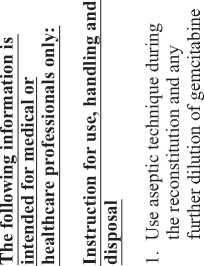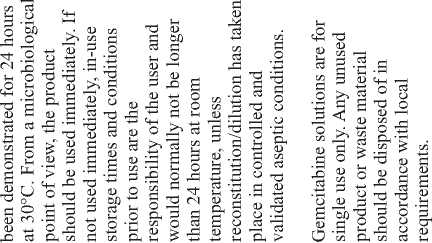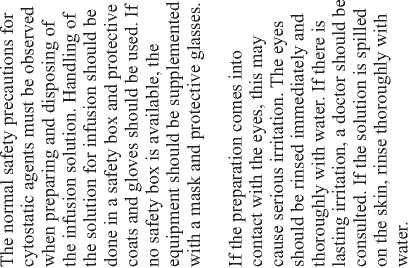Gemcitabine 38 Mg/Ml Powder For Solution For Infusion
Package leaflet: Information for the user
Gemcitabine 38 mg/ml Powder for solution for infusion
gemcitabine hydrochloride
Read all of this leaflet carefully before you start taking this medicine because it contains important information for you.
- Keep this leaflet. You may need to read it again.
- If you have any further questions, ask your doctor, pharmacist or nurse.
- This medicine has been prescribed for you. Do not pass it on to others. It may harm them, even if their symptoms are the same as yours.
- If you get any side effects, talk to your doctor, pharmacist or nurse. This includes any possible side effects not listed in this leaflet.
What is in this leaflet:
1. What Gemcitabine is and what it is used for
2. What you need to know before you use Gemcitabine
3. How to use Gemcitabine
4. Possible side effects
5. How to store Gemcitabine
6. Contents of the pack and other information
1. What Gemcitabine is and what it is used for
Gemcitabine belongs to a group of medicines called “cytotoxics”. These medicines kill dividing cells, including cancer cells.
Gemcitabine may be given alone or in combination with other anticancer medicines, depending on the type of cancer.
Gemcitabine is used in the treatment of the following types of cancer:
• non-small cell lung cancer (NSCLC), alone or together with cisplatin
• pancreatic cancer.
• breast cancer, together with paclitaxel.
• ovarian cancer, together with carboplatin.
• bladder cancer, together with cisplatin.
2. What you need to know before you use Gemcitabine Do not take Gemcitabine:
- if you are allergic (hypersensitive) to gemcitabine or any of the other ingredients of Gemcitabine
- if you are breast-feeding
Warnings and precautions
Before the first infusion you will have samples of your blood taken to evaluate if you have sufficient kidney and liver function. Before each infusion you will have samples of your blood taken to evaluate if you have enough blood cells to receive Gemcitabine. Your doctor may decide to change the dose or delay treating you depending on your general condition and if your blood cell counts are too low. Periodically you will have samples of your blood taken to evaluate your kidney and liver function.
Talk to your doctor, nurse or hospital pharmacist before using Gemcitabine:
• if you have, or have previously had liver disease, heart disease, vascular disease or problems with your kidneys talk to your doctor or hospital pharmacist as you may not be able to receive Gemcitabine
• if you have recently had, or are going to have radiotherapy, please tell your doctor as there may be an early or late radiation reaction with Gemcitabine
• if you have been vaccinated recently, please tell your doctor as this can possibly cause bad effects with Gemcitabine
• if you develop breathing difficulties or feel very weak and are very pale, please tell your doctor as this may be a sign of kidney failure or problems with your lungs
If you develop generalised swelling, shortness of breath or weight gain, please tell your doctor as this may be a sign of fluid leaking from your small blood vessels into the tissue.
If during treatment with this medicine, you get symptoms such as headache with confusion, seizures (fits) or changes in vision, call your doctor right away. This could be a very rare nervous system side effect named posterior reversible encephalopathy syndrome.
Children and adolescents
There is no relevant use of Gemcitabine in the paediatric population. Other medicines and Gemcitabine
Please tell your doctor or hospital pharmacist if you are taking or have recently taken any other medicines, including vaccinations and medicines obtained without a prescription.
Pregnancy, breast-feeding and fertility Pregnancy
If you are pregnant, or thinking about becoming pregnant, tell your doctor. The use of Gemcitabine should be avoided during pregnancy. Your doctor will discuss with you the potential risk of taking Gemcitabine during pregnancy.
Breastfeeding
If you are breast-feeding, tell your doctor.
You must discontinue breast-feeding during Gemcitabine treatment. Fertility
Men are advised not to father a child during and up to 6 months following treatment with Gemcitabine. If you would like to father a child during the treatment or in the 6 months following treatment, seek further advice from your doctor or pharmacist. You may want to seek counselling on sperm storage before starting your therapy.
Driving and using machines
Gemcitabine may make you feel sleepy, particularly if you have
consumed any alcohol. Do not drive a car or use machinery until you are sure that Gemcitabine treatment has not made you feel sleepy.
Gemcitabine contains sodium
Gemcitabine Hetero contains 2.11 mg (< 1 mmol) of sodium per 200 mg vial and 10.56 mg (< 1 mmol) sodium per 1000 mg vial i.e. essentially “sodium-free”.
3. How to use Gemcitabine
The usual dose of Gemcitabine is 1000-1250 mg for every square meter of your body's surface area. Your height and weight are measured to work out the surface area of your body. Your doctor will use this body surface area to work out the right dose for you. This dosage may be adjusted, or treatment may be delayed depending on your blood cell counts and on your general condition.
How frequently you receive your Gemcitabine infusion depends on the type of cancer that you are being treated for.
A hospital pharmacist or doctor will have dissolved the Gemcitabine powder before it is given to you.
You will always receive Gemcitabine by infusion into one of your veins. The infusion will last approximately 30 minutes.
If you have further questions on the use of this product ask your doctor or pharmacist.
4. Possible side effects
Like all medicines, Gemcitabine can cause side effects, although not everybody gets them.
Frequencies of the observed side effects are defined as:
• very common: affects more than 1 user in 10
• common: affects 1 to 10 users in 100
• uncommon: affects 1 to 10 users in 1,000
• rare: affects 1 to 10 users in 10,000
• very rare: affects less than 1 user in 10,000
You must contact your doctor immediately if you notice any of the following:
• Fever or infection (common): if you have a temperature of 38° C or greater, sweating or other signs of infection (since you might have less white blood cells than normal which is very common).
• Irregular heart rate (arrhythmia) (uncommon).
• Pain, redness, swelling or sores in your mouth (common).
• Allergic reactions: if you develop skin rash (very common) / itching (common), or fever (very common). Contact your doctor if you get a severe rash or itching or blistering (Stevens-Johnson Syndrome or Toxic epidermal necrolysis)
• Tiredness, feeling faint, becoming easily breathless or if you look pale (since you might have less haemoglobin than normal which is very common).
• Bleeding from the gums, nose or mouth or any bleeding that would not stop, reddish or pinkish urine, unexpected bruising (since you might have less platelets than normal which is very common).
• Difficulty breathing (it is common to have mild breathing difficulty soon after the Gemcitabine infusion which soon passes, however uncommonly or rarely there can be more severe lung problems).
• Generalised swelling, shortness of breath or weight gain, as you might have fluid leakage from small blood vessels into the tissues (very rare).
• Headache with changes in vision, confusion, seizures or fits (posterior reversible encephalopathy syndrome; very rare).
Side effects with Gemcitabine may include:
Very common side effects
Low haemoglobin level (anaemia)
Low white blood cells Low platelet count Difficulty breathing Vomiting Nausea
Skin rash- allergic skin rash, frequently itchy Hair loss
Liver problems: found through abnormal blood test results Blood in urine
Abnormal urine tests: protein in urine
Flu like symptoms including fever
Oedema (swelling of ankles, fingers, feet, face)
Common side effects
Fever accompanied by low white blood cell count (febrile neutropenia) Anorexia (poor appetite)
Headache
Insomnia
Sleepiness
Cough

Leaflet Size: 220 x 440 mm
Font : Times New Roman
Font Size : Heading 11 pt, rest all 9 pt
Paper Spec.: 60 GSM Maplitho paper both side printing
Colour : Black
This medicinal product is authorised in the Member States of the EEA under the following names:
Germany
France
The Netherlands
Norway
Spain
United Kingdom
Runny nose
Constipation
Diarrhoea
Pain, redness, swelling or sores in the mouth
Itching
Sweating
Muscle pain
Back pain
Fever
Weakness
Chills
Uncommon side effects
Interstitial pneumonitis (scarring of the air sacs of the lung)
Spasm of the airways (wheeze)
Abnormal chest X ray/scan (scarring of the lungs)
Irregular heart beat (arrhythmia)
Heart failure Kidney failure
Serious liver damage, including liver failure Stroke
Rare side effects
Heart attack (myocardial infarction)
Low blood pressure
Skin scaling, ulceration or blister formation Injection site reactions
Adult Respiratory Distress Syndrome (severe lung inflammation causing respiratory failure)
Radiation recall - (a skin rash like severe sunburn) which can occur on skin that has previously been exposed to radiotherapy Fluid in the lungs
Radiation toxicity - scarring of the air sacs of the lung associated with radiation therapy Gangrene of fingers or toes
Marketing Authorisation Holder and Manufacturer
Marketing Authorisation Holder Hetero Europe S.L.
Viladecans Business Park - Edificio Brasil Catalunya 83-85 08840 Viladecans Spain
Manufacturer
Pharmadox Healthcare Limited KW20A Kordin Industrial Park,
Paola PLA 3000 Malta
Gemcitabin Hetero 38 mg/ml Pulver zur Herstellung einer Infusionslosung
Gemcitabine Hetero 38 mg/ml, poudre pour solution pour perfusion
Gemcitabine Hetero 38 mg/ml, poeder voor oplossing voor infusie Gemcitabin Hetero
Gemcitabina Hetero 200 mg;1000 mg polvo para
solucion para perfusion EFG
Gemcitabine 38 mg/ml Powder for solution for
infusion
This leaflet was last revised in 07/2014.
Detailed information on this medicine is available on the web site of Medicines and Healthcare Products Regulatory Agency.
Very rare side effects
Increased platelet count
Anaphylactic reaction (severe hypersensitivity/ allergic reaction) Sloughing of skin and severe skin blistering
Ischaemic colitis (inflammation of the lining of the large bowel, caused by reduced blood supply)
Capillary leak syndrome (fluids from your small blood vessels leak out into the tissue)
You might have any of these symptoms and/or conditions. You must tell your doctor as soon as possible when you start experiencing any of these side effects.
If you are concerned about any side effects, talk to your doctor.
If you get any side effects, talk to your doctor or pharmacist. This includes any possible side effects not listed in this leaflet.
Reporting of side effects
If you get any side effects, talk to your doctor, pharmacist or nurse. This
includes any possible side effects not listed in this leaflet. You can also
report side effects directly via
Yellow Card Scheme
Website: www.mhra.gov.uk/yellowcard.
By reporting side effects you can help provide more information on the safety of this medicine.
5. How to store Gemcitabine
Keep this medicine out of the sight and reach of children.
Do not use this medicine after the expiry date which is stated on the label and carton. The expiry date refers to the last day of that month.
Unopened vial
This medicinal product does not require any special temperature storage conditions.
Reconstituted solution
The product should be used immediately. When prepared as directed, chemical and physical in-use stability of reconstituted solutions of gemcitabine were demonstrated for 24 hours at 30°C. Further dilution by a healthcare provided may be done. Solutions of reconstituted gemcitabine should not be refrigerated, as crystallisation may occur.
This medicine is for single use only; any unused solution should be discarded under the local requirements.
6. Contents of the pack and other information What Gemcitabine contains
- The active substance is gemcitabine (as hydrochloride). One vial Gemcitabine contains 200 mg or 1000 mg gemcitabine. After reconstitution one ml of Gemcitabine contains 38 mg gemcitabine.
- The other ingredients are mannitol (E421), sodium acetate trihydrate (E262), sodium hydroxide (E524) (for pH adjustment) and hydrochloric acid (E507) (for pH adjustment).
What Gemcitabine looks like and contents of the pack
Gemcitabine powder for solution for infusion is a white to off-white lyophilised powder. After reconstitution in 0.9% sodium chloride solution, the solution is clear to pale opalescent and colourless to pale yellow.
Gemcitabine is contained in a flint glass vial with bromobutyl rubber stopper with flip off seal.
Pack sizes
One vial containing 200 mg gemcitabine. One vial containing 1000 mg gemcitabine.

■a
a
-a
a
a
a
_o
C3
U
C5
&
